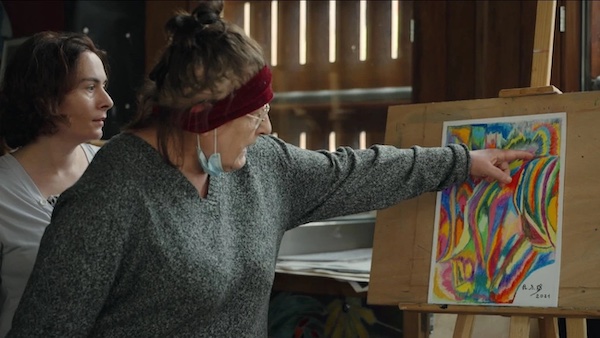Film Review: The Love Barge – Nicolas Philibert’s “On the Adamant” Wins Top Prize at the Berlin International Film Festival
By David D’Arcy
Veteran director Nicolas Philibert’s inspiring documentary about the humane treatment of the mentally ill touched the Berlin jurors in what was a generally disappointing competition.

A scene from On The Adamant. Photo: TS-Production-Longride
Sur l’Adamant (On The Adamant), a documentary about a “day center” for the treatment of the mentally ill on a barge in Paris, was a bright spot in this year’s competition at the Berlin International Film Festival. Things got brighter when the documentary won the Golden Bear, Berlin’s top prize.
The film is the first installment in a planned trilogy about mental health centers in Paris by the veteran director Nicolas Philibert. True to form, Philibert is again working in his gentle style of quiet observation, where conversations tend to reveal a lot about the people who speak to him and the places where these encounters happen.
The two-floor center covered with wooden shutters on a flat floating base is on the Seine, underneath a bridge near the Gare de Lyon train station. It serves four of the twenty Parisian arrondissements that divide the city, but we hear from the clients (patients) that some come from much farther away. You can see why.
Upriver and slightly to the Southeast in what had been a district of railroad warehouses is the modern campus of the Bibliotheque Francois-Mitterrand, one of the massive and faceless grands projets of the former president.
Big boxy ships have been used as spillover prisons bolted to the shore in cities like New York, which also has its own notoriously violent jail on Rikers Island. (Let’s not forget that France gave us Devil’s Island, a prison off the coast of French Guyana where convicts were sent for long terms and the asylum of Charenton, memorably imagined by the German playwright Peter Weiss in his 1963 play Marat/Sade. An institution for the mentally ill still operates on Charenton’s site.)
The Adamant, as designed by the firm Seine Designs (with advice from its clientele) is airy and intimate. The setup is far from the clinical claustrophobia highlighted in 1963’s Shock Corridor, director Sam Fuller’s fictional institutional exposé. It is neither violent nor overcrowded nor overprotected, but it is set apart — a refuge from the city’s everyday activities. This is a sanctuary where conversations happen, and Philibert is there to listen.
The Adamant has a soothing atmosphere that seems to welcome all sorts of human quirkiness, or just assumes they’ll come with the company. The clients shop and cook for each other. They make their own jam from fruit gleaned from trash bins at street markets — an homage to Agnes Varda’s The Gleaners? They can even handle knives, an indication of how safe the place is. They dance on the wooden floor. One man laughs constantly, seemingly uncontrollably, as he serves coffee to another.
The barge can feel like a stage for performances, or at least for self-expression, like the version of the song “La Bombe Humaine” (“The Human Bomb”) from the French band Telephone in 1979 that a client named Francois sings — “You hold the human bomb in your hand/the trigger is right next to your heart.” Another guest sings a song that he says, with disarming calmness, emerges automatically from him. A woman in one of the many group discussions talks endlessly about her commitment to dance, so endlessly that she has to be interrupted, delicately. Some say nothing at those relaxed gatherings. If there is a sentence that we hear repeated, besides versions of “what would you like to eat or drink,” it is “no one is perfect.” The film doesn’t need to state the implied corollary: “everyone is human.”

Director Nicolas Philibert holding the Golden Bear at this year’s Berlin International Film Festival. Photo: BIFF.
And that is another aspect of Philibert’s approach – to discover humanity in state institutions. After all, even with its thoughtful design, manageable scale and gracious staff, The Adamant is a product of the French bureaucracy, part of the Paris Central Psychiatric Group. So was the one-room schoolhouse in a remote village in the Auvergne run by a single teacher in Philibert’s 2001 Etre et Avoir, a bona fide box office hit. So is the massive French radio and television headquarters, also on the Seine, in 2013’s La Maison de la Radio. So was the zoo in the Jardin des Plantes (botanical garden), the subject of a 1995 Philibert documentary. In those films, the director showed us the valuable services that, in the right circumstances, government can provide, that governance and civilization could be mutually supportive.
Watching The Adamant in operation, you also feel at times that the place might simply be too charming for its own good. Hardly a flaw, in my view. Most of the physicians, therapists, and filmmakers (especially documentarians) whom I know would welcome that burden.
Yet if Sur l’Adamant falls in line with the films about museums, zoos, and schoolhouses from Philibert’s long career, it also presents and presumes its own problems, i.e., difficulties that it doesn’t probe. The film is about health and the mysteries of mental health, a field that is messy, unwieldy, overburdened, and underfunded. Philibert has noted this in interviews: “In this extremely devastated context, a place like the Adamant seems a little miraculous, and we have to wonder how long it will last.”
Is The Adamant then (along with the film that observes it) a utopian project whose success will be hard to apply anywhere else? Philibert doesn’t take his inquiry that far.
From what we see, The Adamant works, and Philibert’s inspiring film touched the Berlin jurors in what was a generally disappointing competition. (Commendable decisions by film festival juries, in my experience as a juror and audience member, can seem rarer than mental health day centers that serve their clients well.) Let’s see whether On The Adamant can survive the scrutiny that it is now sure to get when it opens in theaters in France next month.
David D’Arcy lives in New York. For years, he was a programmer for the Haifa International Film Festival in Israel. He writes about art for many publications, including the Art Newspaper. He produced and co-wrote the documentary Portrait of Wally (2012), about the fight over a Nazi-looted painting found at the Museum of Modern Art in Manhattan.
Tagged: Berlin international Film Festival, documentary, Golden Bear, Mental Illness, Nicolas Philibert, On The Adamant
